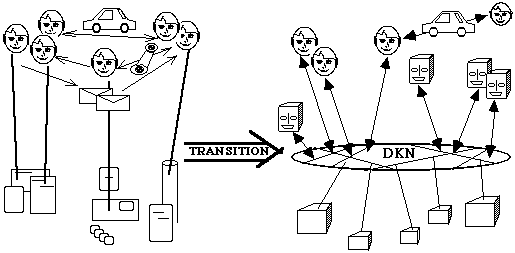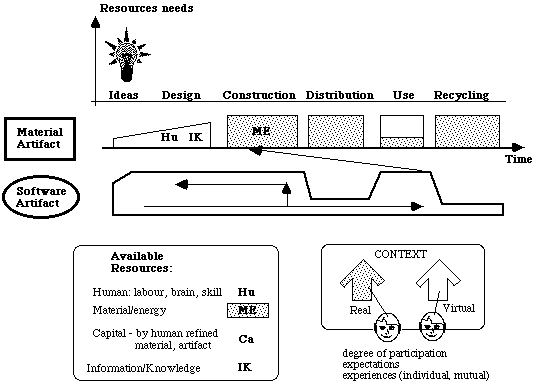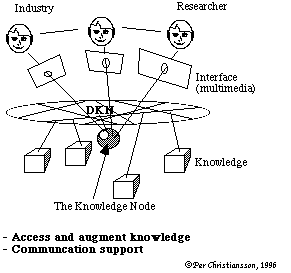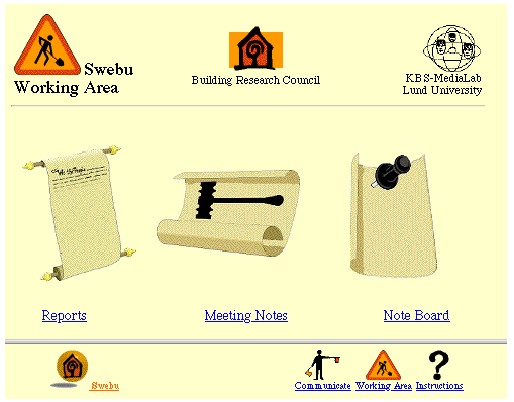Nodes for Knowledge Communication
Assoc. Prof. Per Christiansson
KBS-Media Lab, Lund University, Sweden
(Copyright Per Christiansson, June 2, 1996)
Prepared for
Workshop on "Web as a Shared Design and Prototyping Environment"
IEEE WET ICE Workshops
"Collaborating on the Internet: The World-Wide Web and Beyond"
Stanford, June 19-21, 1996.
Content
Abstract
[top]
The paper presents ideas and models to support the design of future environments for design and knowledge communication on the Internet. Experiences from ongoing research on integration of enabling technologies and how these are used to support collaborative efforts in design are presented. Implementations are done in the World Wide Web and as freestanding applications on the Internet. The conclusions are that the World Wide Web is a good natural base to house connected knowledge chunks and to enhance communication in real to delayed time, and that filtering and quality marking mechanisms are needed, as well as general models to describe global computerized knowledge imposing constraints on knowledge topology and flow. The demonstrator method, incremental prototyping, together with the end users all the way is a successful method in many aspects for idea capturing, participatory design, and continuos work documentation.
1: Introduction
[top]
We are phasing a fundamental paradigm shift which affects our lives in all aspects. The space and time constraints on knowledge creation and handling is changed as we now enter an era formed by the art of communication, succeeding the art of writing 2500 b.c. and the art of printing 1400 a.c. We try to capture and understand the ongoing change process to make better use of the enabling technologies as we the design our future work and living environments.
Constraints produced by the existing non-digital information containers and long access time will diminish. Instead new interesting questions will arise;
- how is information quality defined and assured?
- how can collaboration be improved?
- how can computer interfaces adapt to my expectations?
- how will global computerized models and objects be handled?
- which are the social and cultural impacts?
2: Setting the scene
[top]
Figure 1 shows how we transform our communication infrastructure just now. The Dynamic Knowledge Net, DKN, [4], dynamically connects man to man, man to machine, and machine to machine. The first implementation of the DKN is the World Wide Web, [3]. This first DKN generation has already had a tremendous impact on shrinking the globe to a global village where;
- ideas and research results are immediately available
- the awareness in the social domain is increased
- immediate feed-back can be given as well as communication links established
- a broader spectrum of human values and beliefs are made visible
What see now is the development of a global object-oriented 'operating' system where the Java language plays an important role, [2]. At the same time we produce software artifacts which can be distributed (by other artifacts) and purchased often at a low or no cost at all (only network cost).
The software artifacts can have intelligence built into them through connected agents. An agent is a program that does independent work, changes its own knowledge and communicate with surrounding programs. An agent has mental states, knowledge, skills, and missions [8]. The agent may in-fact also be regarded as a society of agents [10].

|
Figure 1. The Dynamic knowledge Net, DKN will change the way we communicate and handle knowledge.
|

|
Figure 2. Three knowledge domains are defined in [5], the personal, project/company, and global. The personal and project domains can be further divided into a purely internal (private) and external (public) part.
|
From [8]: "The Autonomy Agents perform duties for its user without special interaction with him/her. They work without being tired and without the presence of the user. The indexing agents in the World Wide Web are such artifacts. The Symbiotic Agent acts together with the user. The agents give support by showing alternative or relevant information. These agents may be used in context sensitive help systems where the user intentions are interpreted by the agent. The Anthropomorphic Agent imitates human actions and execute limited tasks as the user would have done. Such an agent can for example do tasks and track the response from an external system to prepare the user better when it is used the next time."
The agent society is only in its infancy. We define and try out different agent definitions; planning (top-down behavior) and reactive agents, agent languages (ACL - Agent Communication Language [1], KQML - Knowledge Query Manipulation Language etc.), direct or broker mediated communication, agent application areas [14], agent properties (lifetime, skills propagation, knowledge domain definition, agent societies) etc.
The different knowledge domains in figure 2 has different degrees of external formalization pressure. The personal internal knowledge domains are formalized individually.
3: Trading knowledge
[top]
Figure 3 clarify how we more and more will use virtual (on contrast to material) artifacts in our daily life and work. Prior to having developed a consensus on better descriptions we call them agents, virtual reality tools, virtual prototyping, digicash, etc.

|
Figure 3. The virtual reality is a cheap way to improve the real reality design solutions.
|
Working in virtual environments has many advantages but also causes new demands
- design transportation costs will be reduced (though the total travel work will probably increase because there will be more interesting persons and places for us to visit)
- projects and teams of persons with needed competencies will be more easily created, managed and dissolved in project or companies
The knowledge broker activities (also supported by agents) will in the future be more spread. We will see the emergence of a more precise definition of meta knowledge domains with respect to deepness and interdisciplinarity. Without doubt many new knowledge domains evolve which today only exist as cross disciplinary, unformalized and rather unconnected islands in existing domains e.g. artifact behavior and their personalities, knowledge navigation, knowledge communication, and new social welfare theories.
What will set the price on knowledge artifacts? The border between sellable and free (paid through common fees as taxes) software artifacts will be shifted. New exclusive knowledge items will be retailed, filtered, and packaged for a wider audience than today. The knowledge stored in persons head will though be as valuable as today. Knowledge about how we learn to learn will be even more important to package when schools and universities get more virtual and suited for space independent personal life long learning. The net based payment method will soon be enough safe to permit secure transactions over the Internet. Many persons will by pure interest and other reasons (honor, barter, appreciation, and even revenge) give away what they believe is important knowledge. This will reduce some of the existing market play grounds dramatically.
We can already today find a lot of frequently asked questions, FAQ, lists and diversified collections of different persons more or less useful knowledge. Persons or agents can be asked to search and filter information eventually with a cost for the service provided. In such a rich and graspable information space it is of great importance that we can judge the quality of the knowledge or get help from persons with documented good judgment. Other type of products will be knowledge packages in the form of objects containing e.g. user models templates, search agents or learning personal agents, process control agents, and team set-up agents, [6].
4: Managing the change process
[top]
It is very important to be aware of that we now are designing the future and merely not computerizing the past. Both a long term and short term perspective must be applied. This fact causes some difficulties as we try to merge conflicting goals from short term pay back wishes and a desire to let free explorative and creative activities bloom. Gradually we can agree on high level formalizations of models for large scale implementation in the DKN. These models on high abstraction levels describes the users, the IT-tools, the applications and contexts we computerize, [5].

|
Figure 4. The Knowledge Node can be regarded as a meta knowledge container and access control mechanism, [6].
|
The following research of our own is used to highlight some important aspects of knowledge communication, [7].
- Knowledge Node, se figure 4, design and implementations; Swedish Building Research on the World Wide Web - SWEBU, Lund University Industry Knowledge Node - MERKURIUS, Maintenance (of Buildings) Experience Communication on the Internet - MAINEX, The Company Knowledge Node - COOCOM2.
- Investigations and implementations of ; user agents on the Internet [8] (how to integrate personal agents with learning capacities in a networked environment), Low Cost distributed Virtual Reality [9] (a low cost distributed virtual reality server on PC platform where two persons can work on the same 3D-model and annotate it. Each person is also visible, if present, as an artifact in the 3D-model to make it easier to collaborate), CSCW (tools for negotiation, [11], and automatic text classification through trigrams and neural network,[12])
We use the demonstrator method (incremental prototyping) as we together with the end users in a mixed competence group continuously capture, communicate, evaluate and implement ideas starting with a user interface layout. The problem definition, conceptual modelling, data modelling and implementation phases are continuously traversed.
5: Collaboration on the web
[top]
During the design and development phase of the SWEBU Knowledge Node, Swedish Building Research on the World Wide Web, the system gradually evolves in participation with the users. A special Working Area is designated to support collaboration over the Word Wide Web. After the system is put in use this area is transformed to a system maintenance area .
The Working Area, WA, is always accessible from any WWW-client (providing you are project participant). It has three different sub areas, se figure 5, Reports, Meeting Notes, and Note Board.

|
Figure 5. When the user click at Working Area in figure 4 he/she enters the project WWW-based Work Area, from [6].
|
Under Reports each project participant have access to a working report which he/she also can update. This is done without leaving the present page in the WWW client. When a part of the report is edited it is not available to the other participants.
The Meeting Notes are updated directly after a scheduled project group meeting and contains meeting notes and figures. In this way each project participant can independent of computer platform, space and time access the meeting notes.
The Note Board is used to make propositions available for comments at any point of time. It is has often been used in different projects to put forward design proposals e.g. alternative user interfaces and data models (tables in a relational database). An FTP image transfer service is also available here.
Clicking at the Communication icon (the semaphoring person) activates a communication window where you can choose between personal or group email, get information about project participants, and how to connect to the video conference server and even establish a group telephone call.
In the beginning of a project the WWW may well be container for both user interfaces and facts bases. As we scale up , see also [6], to a production system which is widely distributed, a separate database, Oracle [13], is implemented. We also use Oracle as a generator for HTML pages to form part of the user interface. Java scripting solves local WWW-client programming for implementation of non-standard WWW-client features.
6: Conclusions
[top]
Some of the conclusions from ongoing work are listed below.
- WWW is a good natural base to house connected knowledge chunks and to enhance communication in real to delayed time (knowledge node)
- cross knowledge domain linkage is important - vocabularies-proximity-synonyms, high level common concepts, abstraction hierarchies and meta knowledge classification,
- user model specifications needed - language, search/navigation/association styles, interests, competencies,
- combine a top-down and bottom-up design in both user interaction (hierarchical concepts and 'free text') and knowledge structuring (redundant storage allowed), search and navigation feedback from systems is crucial - relevance, completeness, thresh holding, index mechanisms,
- filtering and quality marking mechanisms needed,
- general models needed to describe global computer stored knowledge imposing constraints on knowledge topology and flow (trading, ownership etc.)
- demonstrator method (incremental prototyping) together with the end user all the way is successful in many aspects (idea capturing, participatory design, and continuos work documentation)
- capture and analyse instrumental effects of IT and agents (transmission of instrument designer values and intentions)
References
[top]
- ANSI KIF, Knowledge Interchange Format. http://logic.stanford.edu/kif/kif.html. Michael R. Genesereth
- Blundon W. (1996), "How can Java rule the world? Three key steps to Java's success". http://www.javaworld.com/jw-04-1996/jw-04-worldrule.html, (see also http://www.sun.com/).
- Berners-Lee T, 1989/90, "Information Management: A Proposal", http://www.w3.org/hypertext/WWW/History/1989/proposal.html
(see also Cailliau R. "A Little History of the World Wide Web" http://www.w3.org/hypertext/WWW/History.html).
- Christiansson P, 1992, " Dynamic Knowledge Nets in a changing building process". Automation in Construction , Vol 1 nb 4 , March, 1993), Elsevier Science Publishers B.V. (pp 307-322).
- Christiansson P, 1995, "Knowledge Communication in the Global Network". Invited position paper for the July 16-20 1995 Workshop on Research Directions in Architectural Computing. Nemetschek Programmsystem GmbH., Technical University of München, Germany. (To be published by Kluwer). (25 pp.)
- Christiansson P, 1996, "Knowledge communication in the building industry. The Knowledge Node Concept". Construction on the Information Highway". Bled'96 Conference. June 1996
- KBS-Media Lab homepage, http://delphi.kstr.lth.se/
- Lagerstedt R, Christiansson P, Engborg U, 1996, "User Models in Search and Navigation Systems on the Internet". AEC Systems'96, Anaheim June 17-19. (http://delphi.kstr.lth.se/reports/aec96.html)
- Lindeman J. (1996), "Low Cost distributed Virtual Reality". Master Thesis. KBS-Media Lab, Lund University.
- Minsky Marvin, 1985, 1986, "Society of Mind." Simon and Schuster. (339 pp).
- Modin J., 1995, "COOCOM. New ways of using Information Technology for buildings design and management". Lund University, KBS-Media Lab. (SBUF project 2087). (29 pp).
- Modin J, 1994, "KBS-Class: A neural network tool for automatic content recognition of building texts". Construction Management and Economics. Special issue on Information Technology in Construction. 1995.
- Oracle WebServer™, http://www.oracle.com/products/oracle7/oracle7.3/html/web_opt.html
- Rantzer M, 1996, "Intelligenta agenter". Sveriges Tekniska Attachéer, San Francisco, Stockholm. ISRN STATT-UR--96/6-USA--SE. ISSN 1100-2999 (60 pp).





